
Preview GSM smartphone Samsung i300
Samsung i300. Official photos
Review
Windows Mobile 2003 for Smartphone SE: QVGA
resolution and new capabilities
The basis for the manufacturer's development, advancement and, as a result, the growth of the market share supposes not only constant innovations and flexible price policy, but also strengthening its positions in all the price segments. That is a necessary condition for growth. That is true for all the markets with monopolistic competition (when a product is not standardized).
The company of Samsung was treated as a manufacturer of expensive fashionable phones with low-functionality for long. The company was not represented in the low-end segment, and thus an extra-popular Samsung C100 appeared (and all the c-series phones). But still the company lacked "business" phones. And the D500 changed the situation. So, we see the company's growing pressure in various price segments and, as a result, sales growth.
A very important segment that the company was not present in is smartphones and communicators. We got used to the fact the it announces new devices, brings many smartphones from one exhibition to another. But in the end the customer receives only a little part and, moreover, with considerable delay. For instance, Samsung i700 appeared on the market only when it got uninteresting for the majority of the customers (was sold exclusively because of the brand name). All the new smartphones by Samsung were treated as prototypes not for mass production. However the company achieved several goals by showing the developments. First, that was to gain experience in smartphone manufacture and as soon as the direction gets perspective (crosses a critical mass) enter the market with ready products. That is why the company supported all the operating systems for mobile devices (Symbian, Windows Mobile, Windows CE, Linux) to issue smartphones run by the most demanded operating systems when necessary. Second, that is to demonstrate its power, which gives points to the manufacturer's image. That is some kind of PR like a race for higher number of pixels in mobile phones (do you remember a lately announcement of a 7-MP phone?).
At CeBIT 2005 it got clear from the company managers responsible for production that the company changes its smartphone strategy. The devices now will be sold on the global market and, even more, the direction is one of the prior for the company. End users tired of reading about the prototypes doomed to stay on paper now will be able to estimate engineers' efforts. In the current product line "I" series devices run by Windows Mobile are positioned as smartphones, the "D" series means Symbian (Series 60) smartphones, but the company positions them as usual phones (like Nokia does). As we see no space is left for Palm OS, since the company considers this operating system unpromising.

Today we'll tell about Samsung i300. As funny it is the company already issued this smartphone in a distant 2001 (the difference is only seen if looking at the complete index - SPH-i300 and SGH-i300 correspondingly). That was the time when Palm OS dominated, Palm m500 was popular then and only lately the first colour Sony CLIE appeared. And that is why it's not surprising that Samsung i300 based on Palm OS, since no good alternatives were present. According to the users of that time the model was one of the best smartphones for that moment. Read a review of the model in a Pen Computing magazine.
The company already had some experience of Windows Mobile for Smartphone based devices before Samsung SGH-i300, and we are speaking about a CDMA-smartphone Samsung i600. It reached only American Verizon network. Later a GSM-clamshell Samsung i250 was announced and cancelled in the end.
The first information about Samsung i300 appeared in the very beginning of 2005 and the product got known under the name of Samsung Thor (Thor is a mythical god of thunder and fertility). Samsung i300 was officially announced at CeBIT 2005. Our readers could have acquainted with the new device a day before the official announcement.

Samsung i300 is one of the key models of 2005 for the company. That's enough saying the first slide of the company presentation in Hanover showed Samsung i300, which tells about the model's significance for the company. The model combines a new wheel control, integrated 3GB hard drive, a QVGA screen. The model stands out of the general flow and is really innovative (that is impossible to say about the i600 and still unreleased i250). The company positions the device as the first world musical smartphone.
The model will be launched only in October. The current example we tested (an early prototype) lacked a hard drive, we couldn't speak on it (the loudspeaker didn't work), and battery life was close to half a day. So, we couldn't write a complete review of the model and thus publish only a preview. Later when we get a final sample of Samsung i300, we'll return to the model. Now making final conclusions is hard. Well, here is where we can finish an introduction and pass to the main part of the review.
The design is unusual for Samsung, that is the prevalence of strict lines and no smooth forms. The squreness of the body is stressed with a round joystick. The top and bottom planes are splay, and that's why when looking at the side of the device, it looks as an oblong parallelogram. The front elements echo the parallelogram's outline repeating its form. Such a combination of elementary geometrical shapes - a rectangle, a circle and a parallelogram. The smartphone has its own face.

The size of the smartphone is medium, and thus it can't be called either small or big. However the model looses to the last generations of HTC smartphones (bigger, heavier), but is smaller than Nokia N91. It is acceptable to compare Samsung i300 with Nokia N91. The last model is also equipped with a hard drive and is similarly positioned.
- Samsung i300 Ц 113 x 48 x 20 mm, 130 g
- Nokia N91 Ц 113.1 x 55.2 x 22 mm, 160 g
The device is somewhere in the middle between smartphones without a touchscreen and smartphones with a QWERTY-keypad or a touchscreen. When compared with Nokia 6681 it looks smaller and narrower.

The smartphone lies firmly in a man's hand, it is solid. That is mainly due to right proportion of the length and width. It rouses no amazed looks of passers by unlike those large communicators when leant against your ear. The fact women accept the phone well was quite a surprise, the size and weight doesn't scare away. Looking at Samsung's marketing ads we'll see a girl with a guitar and Samsung i300 near her. The company targets the device at girls also; it's not only for men. And that is why there are several colour solutions.

The assembly quality is high; there is no backlash even at strong pressure. The plastic is expensive and pleasant to touch. The black glossy plastic rounds the screen, the camera and a battery compartment. Fingerprints stay on it, but they are mainly unnoticeable unlike Motorola MPx200. The rest of the body is covered with a black plastic also, but it is of another texture, not glossy. The last part may vary in its colour. Only two are foreseen - black (like in the review) and silvery (like on official photos).
An innovation is a control element - a navi wheel with an action button centered in it. It may be used as a usual 9D joystick if pressed in corresponding directions. An alternative variant - scrolling the wheel clockwise or counterclockwise. Wheel scrolling means moving along the list by default. And the faster you scroll, the faster you move in the menu. That is useful when hundreds of compositions are saved in the phone. And now the wheel is responsible for vertical transference along the menu, along the playlist, volume adjustment, zoom, scrolling Internet-pages. This solution is new for the smartphones and adds extra degree of freedom (the thumb through speed is some kind of an analog component). The border like shines due to the backlighting (associations with a nimbus appear), a very beautiful effect appears, a shining border. I won't be surprised if a final variant of the model is provided with a race simulator where the wheel acts as a steering wheel. That is only my supposition (or an offer to the developers), this step would be logical to stress the wheel's capabilities.

It is interesting the wheel was changed while developing the device (look at the official photos and ones in the review). It was primordially placed like in Samsung X810 (that means extra action was necessary for pressure), the texture has changed - it got prominent ribs for better cohesion with a thumb. And finally an "OK" note vanished from the button inscribed into the wheel.
During the detailed tests one more wheel disadvantage revealed, and we hope it will have been improved by the commercial version of the smartphone. It is easier to explain with an example. The wheel rotation is cumulative, that means the system remembers how many degrees you turned the wheel at. Suppose, the "up" or "down" actions snap into work at 30 degrees rotation, and you managed only 29 (the action, naturally, didn't happen and the threshold value is not passed). Then you use the wheel as a joystick moving in various directions, but as soon as you rotate the wheel at one more degree another action takes place. No doubts the disadvantage described is not as significant (it's hard to notice, and one will soon get used if he knows), but that causes useless joystick actions (got not the field you needed, passed a necessary menu item). The software level gives an elementary solution - null the angle when passing to a usual navi mode.

Let's talk about the keypad. The plastic transparent buttons are placed in terraces (the characters are inscribed on a mount), horizontal rows are close to each other and vertical ones are on the contrary distant. The device is well-balanced, the keypad is comfortable to dial a number and enter SMS, and no troubles will appear. The backlighting is even and well seen in the dark.


A loudspeaker for conversations and two light indicators are placed above the screen; they are responsible for the battery charge, Bluetooth work, missed reminders and alarms, being in the coverage zone.
Usually smartphones (let alone usual phones) lack side buttons. I can't remember any other smartphone with so many control elements on sides like the i300. Sides are like studded with buttons, and that is an advantage. They need medium power of pressure and are not pressed accidentally in the majority of cases.

The right side provides a profile button, holding it you turn "aboard a plane" mode (that turns off all the wireless adapters). Then a blocking button for the device, it is to hold for several seconds. A camera button is placed separately. It got lower as compared with the first prototypes; this is for more comfort when shooting in a horizontal mode (the right hand forefinger just lies on it). A T-flash slot covered with a shutter is on the very bottom. These cards are now called micro SD (and a note on the shutter is more likely to have changed by the commercial launch). The max capacity of such a card for today is 256 MB (the price is about 55 USD). Hot card change is supported. The card capacity is not very important due to the presence of a 3GB hard drive.

The left side holds a Samsung headset connector covered with a shutter. Then a dictaphone button, holding it we launch voice dialing. Lower - a musical button responsible for calling the player, lower it - coupled volume buttons. As we see, the i300 is high above all as for its control elements, this is due to the unique wheel, plenty of buttons that theoretically may perform several actions each (that's a pity you can't assign programs and actions to the buttons yourself).
The top end of the phone has an IrDA, a strap hole (early prototypes lacked it). There is a synchronization connector on the bottom end, and it serves for charging the device also. The device supports "Plug & Play Files-to-go" technology, which means the smartphone is connected to a USB 2.0 as a storage device without any drivers which is convenient. Thus we get an original mobile storage device. An interesting question is the hard drive speed, but answering it will be possible only after we get a final example.
The back shows a camera with a flash integrated into the metallic edging. The battery also serves as a back cover. A standard SIM-card holder is under it. Battery life is now hard to speak about due to the smartphone incompleteness, we'll certainly return to this question in the review. The main intrigue is how long the device will play music non-stop. That is the main problem of the development. If it is several hours (that is for March 2005), then the sense of the integrated hard drive is mainly lost (why to write hundreds of compositions if the charge is enough only for one tenth of them?). One of the possible variants is a microSD as a buffer, which allows turning the hard drive on only seldom.
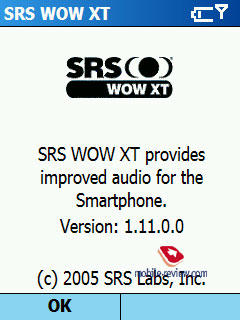
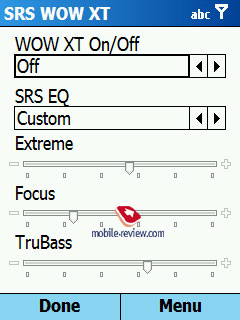
Having looked at the back of the phone we'll see two loudspeakers (they are directed to different sides at right angles) providing stereo sound. SRS WOW XT is used. The core of the utility is to create stereo sound using two closely placed loudspeakers (details on the company's site). We won't comment stereo sound now (the loudspeakers are low, stereo effect is not felt), let's wait for the final sample.
Samsung i300 is one of the first QVGA smartphones (320x240 pixels screen resolution). Gradually this resolution will become a standard for Windows Mobile devices. The difference from the previous models is amazing, the picture is more detailed, the fonts are smoother, surfing the Internet got better. Physically the screen supports 262K colours, but the operating system allows not more than 65K. Let's compare the screen with the rivals.
- HTC Hurricane Ц 1. TFT QVGA display, 262K colours, 44.5x33 mm (diagonal -2.2")
- Samsung i300 Ц 1. TFT QVGA display, 262K colours, 40x30 mm (diagonal - 1.97", almost 2")
- Nokia 6681 Ц 1. 176x208 pixels, 262K colours, 41x34 mm (diagonal - 2.13")

In all the cases announced 262K is a marketing measure; a user won't notice any improvements. Really the Samsung i300's screen looses to the HTC Hurricane's one in size, and all the rest parameters coincide, that is colour rendering, good viewing angles (the picture is seen well in any angle and from any side). Unlike HTC Hurricane the i300 has no automatic tuning for screen backlighting that depends on the lighting conditions, although it provides a manual one (totally 10 levels). The screen fades in the sun, but is still readable (behaves absolutely similar to HTC Hurricane, the matrix manufacturer is the same). Almost nothing is seen in the sun if the minimal backlighting level is set or the battery is seriously discharged (backlighting level drops 10% automatically then). The i300 will provide not the best screen for the launch time, since it is a bit small.
HDD
A standard diameter of a hard drive plate of a desktop PC forms 3.5", for notebooks that is 2.5. Mobile disks start with 1.8" diagonal and less. In its time the appearance of 1" disks (Microdrive in a Compact Flash format) was a great event. But with time this solution was left due to the growing capacity of usual Compact Flash cards and the fall of their price. With the appearance of 0.85" disks, the fall of the price and the growth of the 1.8" b1" disks capacity the interest reappeared. Starting with this very year we'll see hard drives integrated everywhere from digital cameras to mobile phones.
Samsung i300 will be equipped with 0.85" 3 GB hard drive. We'll return to the question in the full review.
Bluetooth
Home Microsoft drivers that allow playing music via a stereo Bluetooth headset were used for Bluetooth realization.
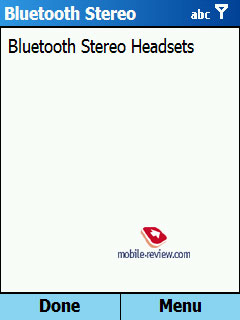
Bluetooth capabilities include:
- Entering the Internet from a PC or a PDA
- OBEX - file transfer (both on the device and from it)
- OBEX object push
- Serial port - data synchronization
- Working with a Bluetooth-headset
Camera
The camera integrated is 1.3MP with the max picture resolution of 1280x1024 pixels. You can set a compression level besides the resolution, select from Fine, Super Fine, Normal, Economy. The device is at an average level as for the number of settings.
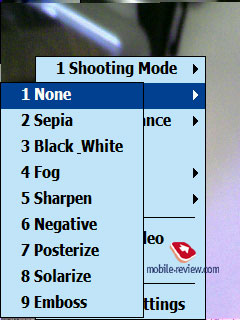
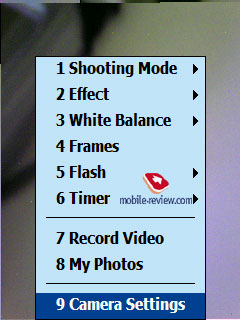
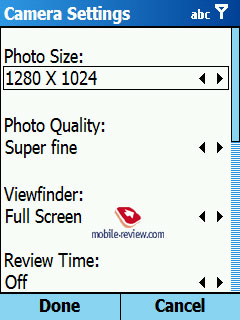
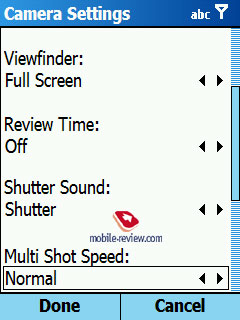
The screen is also a viewfinder, direct at the object and shoot. The icons displayed on the top of the screen tell about the current shooting settings. The wheel rotation is responsible for digital zoom.
The device seemed unstable as for the picture quality; it can give both photos comparable to Nokia 6680/6681 and very weak ones. By the final release the camera can either improve (get the level of Nokia 6680/6681) or remain the same. Anyway the device will loose to Nokia N90, Nokia N70, and Sony Ericsson k750i.
The max video resolution is 320x240 pixels.

All the shot material may be viewed through My Items.
Specifications
There is 64 MB of RAM and 51.50 of them are available. The available flash memory forms 18.38 MB; it is for storing user's data. Approximately the same indexes as for HTC Hurricane.
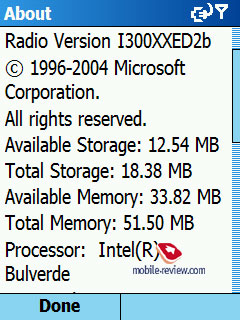
The CPU is Intel XScale PXA272 with the max standard clock rate of 312 MHz. As the PDA tests showed the processor is easily accelerated to 520 MHz (you can only loose your data). After the device is launched, corresponding utilities for acceleration will appear soon.
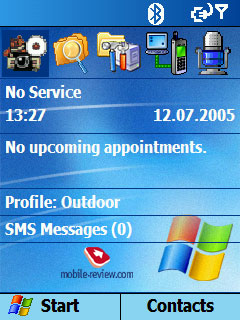

Software
Despite the device is announced on a new WM 5.0 OS, it will be sold run by an old operative system, more likely no upgrade will be committed. A special article will be devoted to standard software on Windows Mobile 2003 SE for QVGA resolution (now read a review about WM2003SE for Smartphone for 176x220 screens). Let's tell about the programs not included into the standard kit.
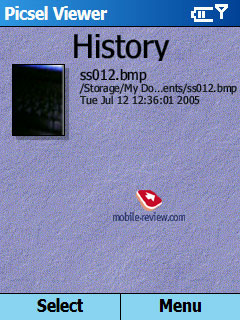
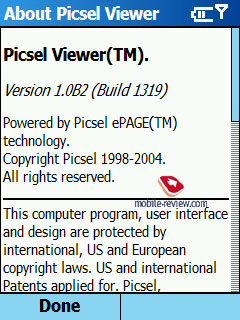
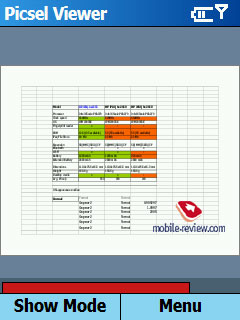
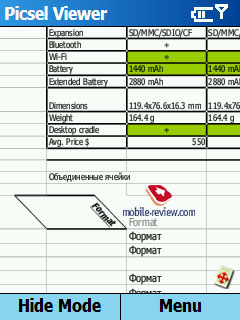


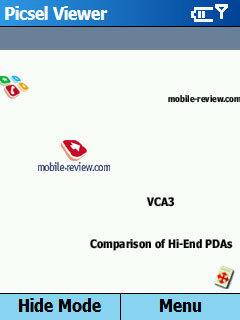
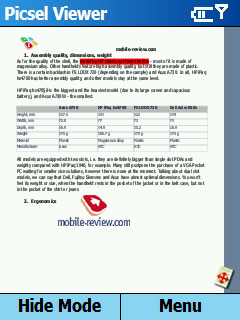

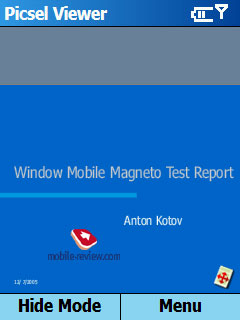
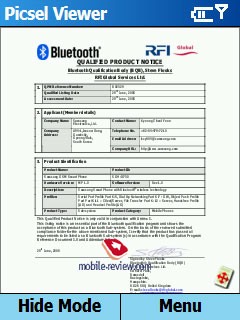


Picsel Viewer. This program for viewing office documents gets a standard for Samsung top products. The program correctly shows documents with all the formatting kept. Neither Office Mobile in Window Mobile 5.0 nor Documents To Go in Palm OS can show documents as carefully as Picsel Viewer.
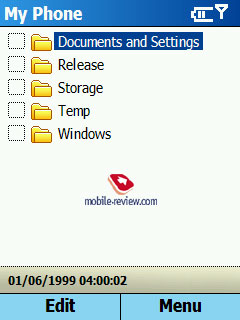
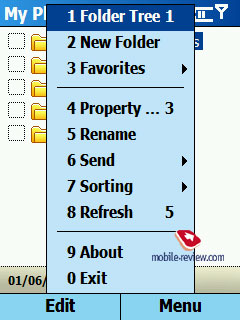
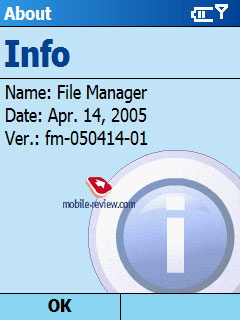
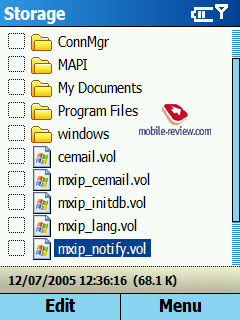
File Manager. Basic operations with files - copy, delete, transfer. It is possible to make ZIP archives and extract files.

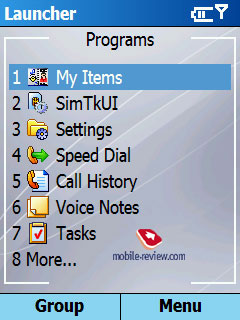
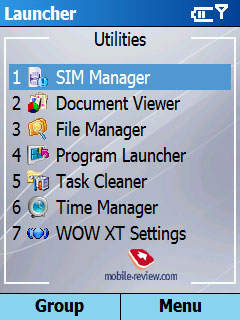
Program Launcher is an alternative to the "start" button. It is a program for launching an application, it's unclear if it is necessary.
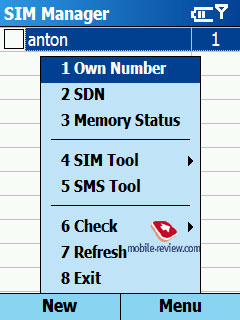
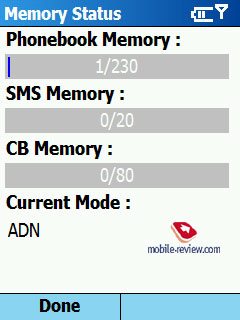
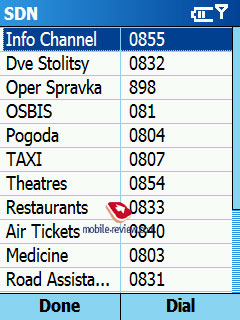
SIM Manager. Everything is clear - working with a SIM-card.

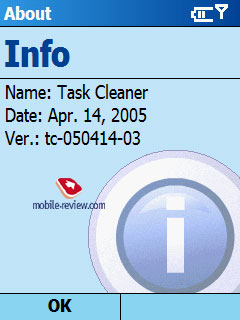
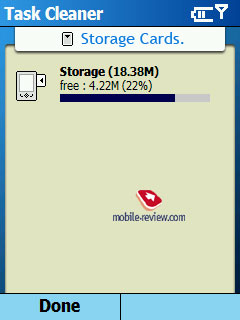
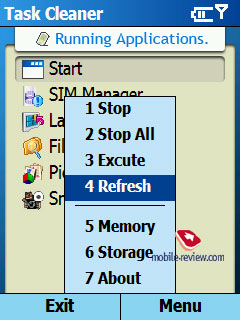
Task Cleaner. Closes unnecessary tasks to free some memory.
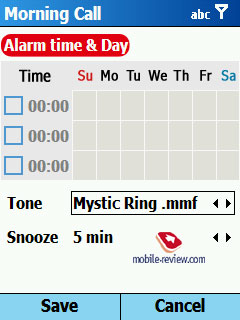
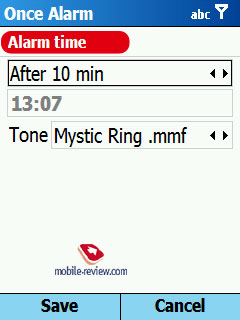
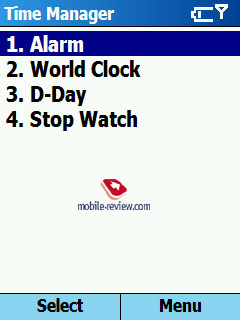
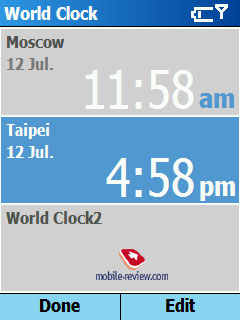


Time Manager. Expands a standard calendar. Alarm clock, world time, reminders.
WAP Browser Ц integrated IE supporting WAP sites, no need in a special browser. It's unclear why to install one more WAP browser.
Three is a voice control program - Voice Assist. We failed test its work.
Only a back-up program is lacking as well as the one for showing callers' photos.
Conclusion
You can set MMF, MIDI, WMA or MP3 files as a call melody. The device may be also used as an external USB- or IrDA-modem. Only MMF and MIDI files sound well, MP3 compositions are low. Let's think it's caused by the raw example.
The device is expected in October for about 700 USD, which is for the start of the sales, and then the price will fall to 550 USD.
Now it's too early to make final conclusions, let's postpone them till the complete review. But we can surely stress the main points. Samsung i300 has no rivals in the control elements, which is an advantage. That is for the first time we see a hard drive in a smartphone. The screen resolution forms 320x240 pixels that is also an advantage, tough the screen size is not optimal at all. Still battery life, final camera quality and performance remain unknown.
|



